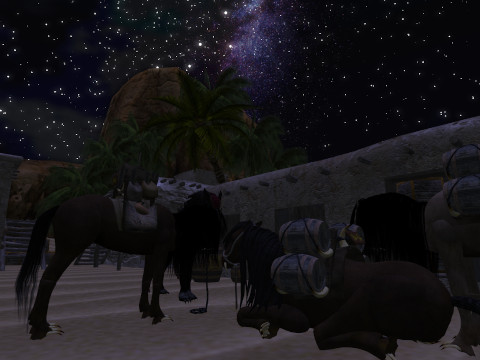First View: Oasis of Klima, rebuilt
“In the distance, below, perhaps five pasangs away, in the hot, concave, white salt bleakness, like a vast, white, shallow bowl, pasangs wide, there were compounds, low, white buildings of mud brick, plastered. There were many of them. They were hard to see in the distance, in the light, but I could make them out.
“Klima,” said Hamid.
“I have made the march to Klima,” said one of the prisoners. He cried out, elatedly, “I have made the march to Klima!” It was the man who had, for many of the days, cried out for us to be slain. It was he who had, since the noon halt of four days ago, been silent.
I looked at the prisoners. We looked at one another. Our bodies were burned black by the sun. The flesh, in many places, had cracked. Lighter colored flesh could be seen beneath. There was salt on us, to our thighs. The leather wrappings about our legs were in tatters. Our necks and bodies were abraded, raw from collar and chain. In the last days we had been denied salt. Our bodies were cruel with cramps and weakness. But we stood, all of us, and straight, for we had come to Klima.”
“The surface temperature of The crusts would be in the neighborhood of 160 degrees Fahrenheit. The air temperature would range from 120 to 140 degrees Fahrenheit.”
“Needless to say, Klima contains as well, incidental to the salt industry entered there, the ancillary supports of these mining and manufacturing endeavors, such as its kitchens and commissaries, its kennels and eating sheds, its discipline pits, its assembly areas, its smithies and shops, its quarters for guards and scribes, an infirmary for them, and so many respects Klima resembles a community, save that it differs in at least two significant respects. It contains neither children, nor women.”
“How,” I asked, “does one become kennel master?”
“Kill me,” said T’Zshal.
“It was cool in the pit, on the large raft. At each corner of the raft, mounted on a pole, was a small, oil-fed lamp [kommt noch]. It was dark in the pit, save for our lamps, and those of other rafts.”
“The retaining vessels are, at the salt docks, lifted from the rafts by means of pulleys and counterweights. The crew of a given raft performs this work. When the retaining vessels are suspended, they are tipped, and the sludge scooped and shoveled from them into the wide-mouthed, ring-bearing lift sacks… These ropes run in systems to the surface and return.”
“Klima has its own water, but it is dependent on caravans for its foods. These food stores are delivered to scouted areas some pasangs [several kilometers or miles] from the compounds”.
“The salt in solution is obtained in two ways, by drilling and flush mining and, in the deeper pits, by sending men below to fetch the brine. In the drilling and flush mining, two systems are used, the doublepipe system and the separate-pipe system”.
Leave a Reply
You must be logged in to post a comment.












